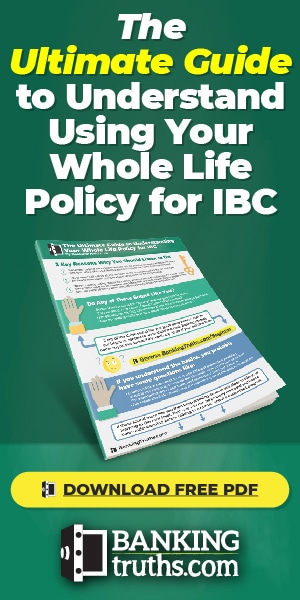IUL or Buy Term and Invest the Difference?
This case study revisits the age-old argument of whether to buy term and invest the difference or to bundle both into IUL for a 61-year old business owner.
IUL or Buy Term and Invest the Difference?
Let’s explore the age-old debate of buying term and investing the difference or bundling the two inside of an IUL policy.
And we’re going to come at it from a whole new angle.
What you’re looking at here is a policy on a 61-year-old business owner. He’s in standard health in his term premium for a five hundred thousand dollar policy for a 10-year level term is $3,445. Now the same five hundred thousand dollar policy into a max funded IUL policy for six years is forty thousand dollars and that’s what you’re seeing down here depicted in these blue lines, this is cumulative premium.
After six years, he would have paid two hundred and forty thousand dollars into the IUL – no further premiums are due, as opposed to paying just twenty thousand at this point of the term policy. And at the end of 10 years, he would have spent a total of $34,450.
Now, most people are saying, “Why in the world would I pay all this money to an insurance company when I can only pay them this and I can get a better rate of return elsewhere”.
Maybe so, maybe not. That’s what we’re going to take a look at.
So let’s look at each policy individually now with my handy dandy software here. When the software shows you shaded lines, that indicates we’re looking at one single policy. So the first one is the term policy.
And as you can see, at the end of 10 years he would have paid thirty-four thousand as we spoke of. This death benefit, the green line of five hundred thousand this should go away. But it does continue because I’m sure some of you have experienced this if you want to continue your term after the term is up.
In this case, he could do so for the low low price of (if you watch the blue numbers on the left) about a forty-eight thousand dollars premium for one more year of term that builds no surrender value, produces no income. But if he wanted continuous coverage he could do so for that.
Most people choose not to do that, they have no intention of doing that. However, sometimes circumstances dictate that that may be worthwhile.
In this case, this is the IUL policy. Again we pay $40,000 of premium in the first year. Now notice that the death benefit increases it’s going up and to the right. That’s because we’re using an increasing death benefit policy and it goes up by the amount of policy value, money in the policy growing for the client which is different from surrender value. That’s how much the client has access to inside the policy.
Now with this particular policy, we are using an enhanced cash value rider and what you can see is in that first year he’s paid $40,000 of premium but he could surrender the policy for $36,815.
What’s interesting is if he would surrender his term policy after the first year, so we’ll just take the amount they would have invested – forty thousand dollars less the term premium. So what’s interesting is if he surrendered the term policy at the end of the first year, he’d only have $36,555 in his savings account.
Could he could he have gotten a better rate of return elsewhere? Possibly. But I asked this business owner, “For your working capital, for buying trucks, for floating payrolls in between receivables coming in – do you invest that money into mutual funds stocks or bonds or do you keep it in cash?”
And what do you think he told me? He keeps it in cash. And he had a decent amount of cash and cash flow just languishing, sitting in bank accounts.
So what we talked about was, you could buy term but you may want to consider this IUL policy because it does have a zero percent floor so you’re protected against market risk. And if we add this enhanced cash value rider, you actually have access to a good amount of this money.
If we scroll forward here we can see visually that the orange line tracks the blue line quite nicely. And at the end of the sixth year when 240 of premiums gone in, he’s got 240 of surrender value, he actually even got more in policy value because this death benefit goes up by how much policy value is in there. So you can see there’s about 250 to almost 253 of money in there earning interest for him.
So no further premiums are going in, the death benefit flatlines there. You can see the surrender value will start to converge on that death benefit. But this business owner admitted that he wanted to sell sometime between year seven and year 10. So he didn’t mind that the amount of net coverage he had went down.
At the end of the tenth year, remember in the term situation, unless he paid a crazy premium, the death benefit would go away. We actually manually reduced the death benefit here so we can optimize this policy for income, so we’re simulating the fact that his business is probably sold at this point and he does want to start to pull some tax-exempt income from this policy.
If we just move to year 11 here between 10 and 11, you can see the purple line is showing twenty thousand dollars of tax-exempt income. Now I want to say that all of this is based on a projection of 6.35%. So we’re assuming that this IUL policy averages a crediting rate of 6.35%.
I don’t know how many of you know this but the insurance industry has regulated what’s able to be shown by insurance companies and insurance agents by something called AG 49 or actuarial guideline forty-nine.
And what AIG 49 says is that you take a particular policy and index policy’s parameters, their growth parameters, their floor, in their cap and what index they’re tracking, and you have to look back 65 years to see how this policy would have performed in a back-tested environment.
Actually, they don’t just take the average of the 65 years, what they do is they take every twenty-five year rolling period or every twenty-five-year slice of that sixty-five year history and they average all of those to come up with the AG 49 rate.
This 6.35% is actually a percent below the AG 49 rate. So this is how much income and how much growth he would get in the policy using those parameters.
I actually ran the AG 49 rate as well. If we look at that, you can see the surrender values actually a little higher all long. So if you remember at the end of the sixth year instead of being 249 thousand ahead, his surrender value would be even further ahead – about the same nine thousand dollars.
And then when we got to the end of the 10 years, when he wanted to take income, given this average throughout the life of the policy, this policy would support more income instead of twenty thousand dollars, twenty-nine thousand dollars of income. And we ran this all the way to age 90.
Now some people say, “Maybe this is not a great income number maybe the net IRR or the internal rate of return which is different from the crediting rate. Maybe that isn’t the best crediting rate I could get”. And that’s actually what this business owner said to me.
He said, “You know I’m just thinking of the cash flows here and if I put two hundred and forty thousand dollars and I take all this income, you know could I get a better rate of return elsewhere?”.
And I had to remind him, “Yes maybe you can. But can you, given the same risk profile? So are you ready to take that working capital, take the money that you have personally that you like to keep in cash in case you have to loan it to the company, are you prepared to put that at risk?”
And he clearly stated “No“.
And I said, “You know as far as a risk-adjusted rate of return, it’s actually quite compelling and that what we’re looking at here is the spreadsheet version of the term policy, the Indexed Universal Life policy is 6.35%. And also this same Indexed Universal policy at 7.35%.
And when we just look at term, even though your outlay is a lot less. So we’re skipping every two years here and you could see how much premium has been paid and we just started at age 65. You’re paying less money but your internal rate of return is negative one hundred which by the way most people mistake when I say if you pay into a term policy for 10 years and you get no money back – what’s your rate of return?“
They’ll tell me zero. And it’s not zero. It would be zero if you’ve got all your money back. But in this case, you don’t get any money back from the insurance company unless you die early so your rate of return is actually negative one hundred.
If you want to get the best rate of return out of a term policy, just die early. It gets really really good. But most my clients don’t want to sign up for that program and that’s why IUL can be a great alternative because during the funding period the return is almost the same as putting money into a savings account and deducting money for term.
If we get a decent return it could be better. And as you stop paying premium and the money grows, this is not a bad rate of return for something where you’re not taking any market risk and it’s fully accessible to use for those trucks or equipment or payrolls or whatever that is.
Once you start taking income, this return on surrender value is taking into account how much you put in, how much you’re taking out for income, and it’s calculating the total return of what’s left in the policy to be taken out for income. It’s not too bad at 6.35%. It’s even better at 7.35%.
But I have to remind clients that they’re probably not going to leave the undertaker with the bill, so they’re probably not going to completely cannibalize the policy and leave some sort of death benefit. Some sort of small death benefit behind for heirs, even if they pull out a lot of income, in which case we need to factor that into the equation.
And when we take the total return of not only the income you took out but the death benefit that’s left behind as well – well now all of a sudden, whether you get 6.35% or 7.35%, it’s really pretty good. Especially since you consider that when you leave any amount of death benefit behind everything is tax-free.
All the income is forgiven whether it was a loan or whether you took out withdrawals, the basis and the death benefit is also tax-free. And so when you take into account that none of this money is taxed, you didn’t take any risk and you had full accessibility and liquidity throughout this process.
They all of a sudden find that this is a pretty attractive rate of return.
Click here to schedule a call with us to take a deeper dive into Indexed Universal Life to help you understand how this could look for your situation going forward.

John “Hutch” Hutchinson, ChFC®, CLU®, AEP®, EA
Founder of BankingTruths.com


